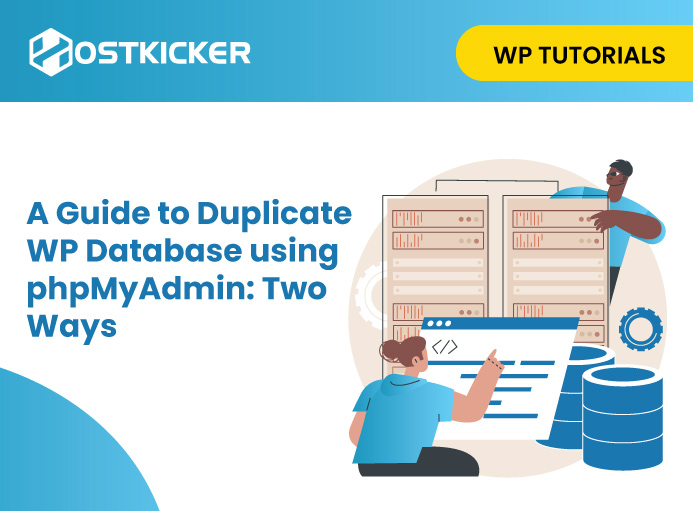A Guide to Duplicate WP Database using phpMyAdmin: Two Ways
Do you want to move your site to a new host or create a backup of your site? You’d need to duplicate WP Database using phpMyAdmin.
Typically, a database stores your WordPress content. WordPress is a valuable platform that allows users to create websites. However, managing its database can be a daunting task for beginners, particularly when it comes to creating duplicates for testing, development, or backup purposes.
Learning ways to replicate a WP database using phpMyAdmin can be helpful for website owners and developers. In this detailed guide, we’ll cover the step-wise process of duplicating the WordPress database easily. Whether you’re aiming to experiment with new features, safeguard your site’s data, or streamline your development workflow, mastering this method will equip you with the skills to manage your WordPress databases efficiently.
What makes phpMyAdmin ideal for Duplicating a WP database?
Notably, WordPress stores all the website data in the MySQL database.
You can easily access MySQL Database using a variety of ways, including command-line tools and phpMyAdmin.
The command-line tools are generally not friendly for beginners and are also not considered ideal for coding wizards.
phpMyAdmin, on the contrary, is user-friendly and includes an intuitive interface, allowing users to easily manage their databases. Also, it does not require writing complex commands.
Moreover, you can use phpMyAdmin to reset your WP admin password, move your site to a new web host, or deactivate plugins if you are unable to log in to your WP dashboard.
Now that you know why you should use phpMyAdmin to duplicate the WP database, it is time to go over the steps to duplicate WP Database using phpMyAdmin in cPanel.
How to easily Duplicate the WP Database using phpMyAdmin?
This section will help you find the step-wise method to easily Duplicate WP Database using phpMyAdmin. First of all, you’d need to access your website’s cPanel, provided by your web host, to move forward with this process. Below, we’ll discuss two ways to use phpMyAdmin to replicate the WordPress database. The first method allows you to copy the database directly, and the second method uses the export-import technique to copy the database where your host does not allow you to create a database directly.
So, without ado, let’s get started.
Process 1: Duplicate WP Database using phpMyAdmin
Step 1:Navigate to phpMyAdmin

In order to navigate to phpMyAdmin, you first need to log into your cPanel. Note that your cPanel may appear different due to your hosting, but the steps are identical.
So, first, log into your WordPress cPanel and look for the database section. Your phpMyAdmin is typically located inside the database section.
Simply click on the “phpMyAdmin” option.
Step 2: Click on Database inside phpMyAdmin
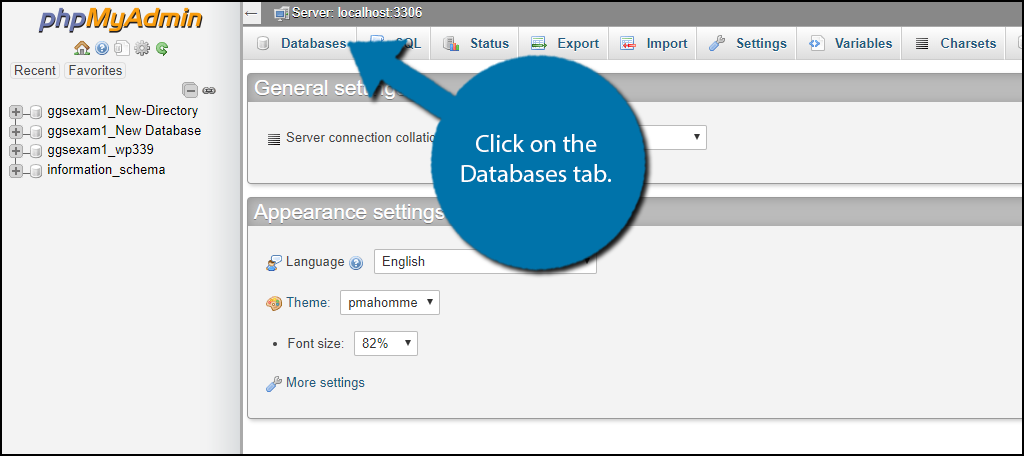
Once you are inside the phpMyAdmin, look for the database option, which is typically located at the top. Now, click on the “Database.”
Step 3: Click on WordPress Database.
Now, you need to locate your WordPress database inside the database tab to move ahead.
There, you’ll find various database options, so determine which one is a WP database and then click on it.
In case you find it difficult to locate your WP database, look for the file starting with the “WP_” prefixes. You may also locate it in your wp-config.php file.
Step 4: Duplicate WP Database using phpMyAdmin
Now, inside the WP database, look for the “Operations” tab and click on it. Now, this is the section where you can duplicate your WP database.

In this section, you’ll find four options: “Create table,” “Rename database to,” “Copy database to,” and “Collation.”
Now, go ahead and click on the “Copy database to” option.
There, enter the new database name. Now, ensure the ‘Structure and data’ box and the ‘Create DATABASE before copying’ option are checked.
You can keep the rest of the settings as they are.
Now, click on the “Go” option to replicate it.

When the process is ended, a success message will appear on your screen. The processing time may vary depending on the size of the database.
That’s it! You have successfully replicated your database.
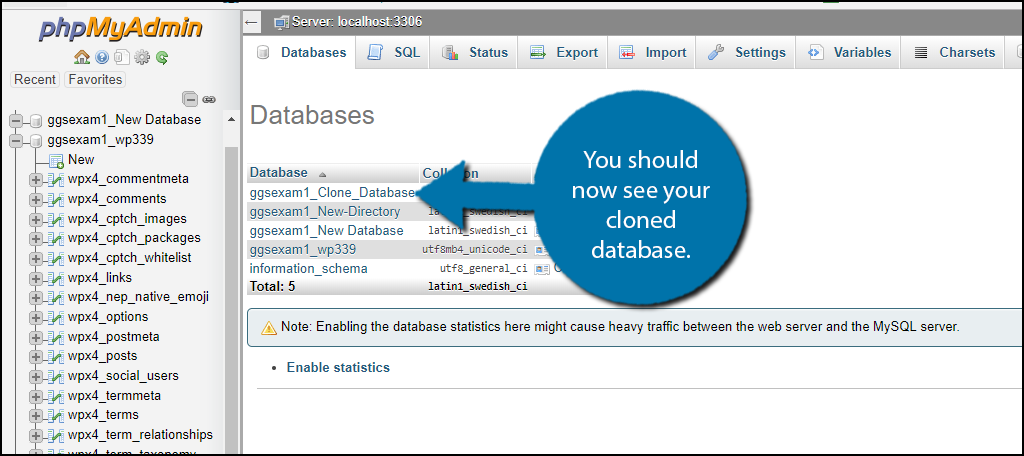
To see your newly created database, you can click on the “Database” tab.
Process 2: Export Import method to Duplicate WP Database using phpMyAdmin
In case you use shared hosting services, your web host may restrict some of the features due to security purposes. So, this method will help you if you cannot create a database from your phpMyAdmin directly.
If this is the case, you may not see the ‘Copy database to’ option within the ‘Operations’ tab. So, you can use this export-import method to duplicate WP database using phpMyAdmin. Here, first, we’ll export the database SQL file, set up a new database, and import the file.
Step 1. Follow the Above Three Steps
To proceed with this method, the first three steps we stated above are the same.
phpMyAdmin>>database>>WP database
Step 2. Click on the Export Tab
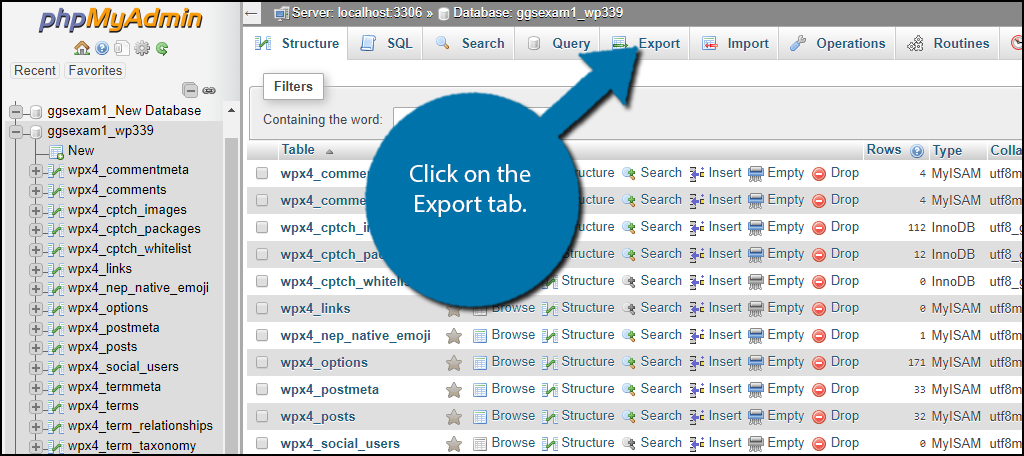
Now, instead of navigating the “operations” tab, look for the “Export” tab and click on it.
Then, inside the export tab, select the ‘Custom – display all possible options’ radio button.
Now, scroll down and look for the “Output” section. Inside it, select the
“Save output to a file” radio button. Now, keep the rest settings as they are.
Now, click on the “Go” or “Export” option. This will save your database file as an SQL file on our web browser.

Step 3. Create a new database
Now, to import your file, you need to create a new database.
For this, go to your cPanel and look for the “Databases section.” Once there, click on the ‘MySQL Databases.’

Now, enter your new database name and click on the ‘Create Database’ button.
After this, click on “Go back” and look for the ” Add User to Database’ section.

Then, choose your current MySQL username from the dropdown menu and select the new database file you just created in the ‘Database’ field.
After this, click on the “Add” tab just below it. Now, you have created a new database.
Step 4. Click on the Import Tab
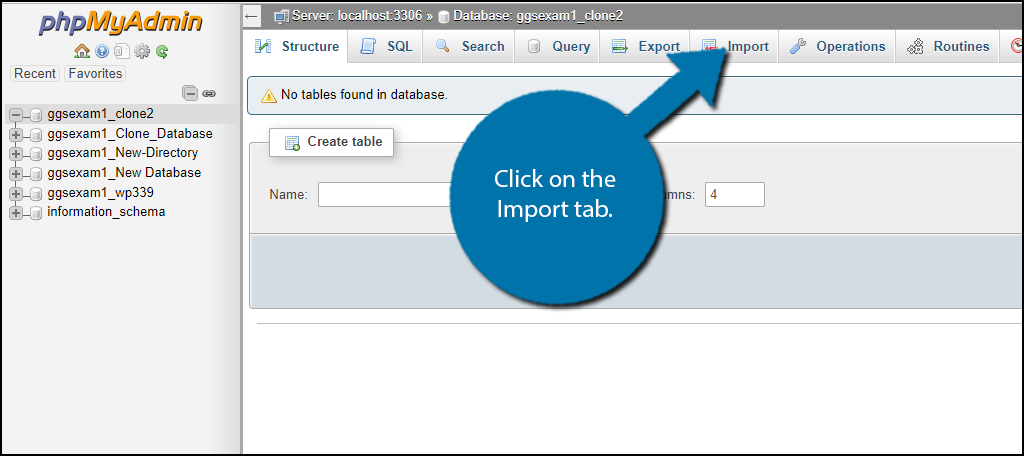
Now, return to phpMyAdmin, look for the Import tab on the top, and click on it. Once there, select the “Choose File” tab and add the SQL file you exported earlier.
When done, click on the “Import” or “Go” tab. It will now upload the file from your computer and import your database from your computer.

That’s it! You have successfully learned to duplicate WP database using phpMyAdmin.
It’s recommended that you store your files somewhere else from your original database if you are using them as a backup. This will ensure that your data is always secure, even in emergencies.
Final Thoughts!
As we conclude our guide to duplicating WordPress databases through the user-friendly interface of phpMyAdmin, it’s evident that mastering this process offers immense value to website owners and developers. The ability to seamlessly replicate databases for testing, development, or backup purposes is a skill that streamlines the management of WordPress sites.
By following the step-by-step instructions stated in this guide, duplicate the WP database using phpMyAdmin. Whether it’s experimenting with new features, safeguarding critical data, or simply optimizing your development workflow, the proficiency in duplicating databases using phpMyAdmin empowers you to take control of your WordPress site’s database management.
